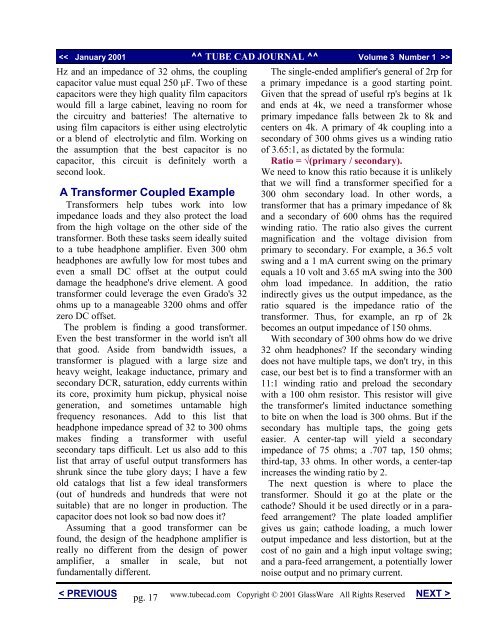Inverted Shunt Regulator - Tube CAD Journal
Inverted Shunt Regulator - Tube CAD Journal
Inverted Shunt Regulator - Tube CAD Journal
You also want an ePaper? Increase the reach of your titles
YUMPU automatically turns print PDFs into web optimized ePapers that Google loves.
Hz and an impedance of 32 ohms, the coupling<br />
capacitor value must equal 250 µF. Two of these<br />
capacitors were they high quality film capacitors<br />
would fill a large cabinet, leaving no room for<br />
the circuitry and batteries! The alternative to<br />
using film capacitors is either using electrolytic<br />
or a blend of electrolytic and film. Working on<br />
the assumption that the best capacitor is no<br />
capacitor, this circuit is definitely worth a<br />
second look.<br />
A Transformer Coupled Example<br />
Transformers help tubes work into low<br />
impedance loads and they also protect the load<br />
from the high voltage on the other side of the<br />
transformer. Both these tasks seem ideally suited<br />
to a tube headphone amplifier. Even 300 ohm<br />
headphones are awfully low for most tubes and<br />
even a small DC offset at the output could<br />
damage the headphone's drive element. A good<br />
transformer could leverage the even Grado's 32<br />
ohms up to a manageable 3200 ohms and offer<br />
zero DC offset.<br />
The problem is finding a good transformer.<br />
Even the best transformer in the world isn't all<br />
that good. Aside from bandwidth issues, a<br />
transformer is plagued with a large size and<br />
heavy weight, leakage inductance, primary and<br />
secondary DCR, saturation, eddy currents within<br />
its core, proximity hum pickup, physical noise<br />
generation, and sometimes untamable high<br />
frequency resonances. Add to this list that<br />
headphone impedance spread of 32 to 300 ohms<br />
makes finding a transformer with useful<br />
secondary taps difficult. Let us also add to this<br />
list that array of useful output transformers has<br />
shrunk since the tube glory days; I have a few<br />
old catalogs that list a few ideal transformers<br />
(out of hundreds and hundreds that were not<br />
suitable) that are no longer in production. The<br />
capacitor does not look so bad now does it?<br />
Assuming that a good transformer can be<br />
found, the design of the headphone amplifier is<br />
really no different from the design of power<br />
amplifier, a smaller in scale, but not<br />
fundamentally different.<br />
< PREVIOUS<br />
pg. 17<br />
The single-ended amplifier's general of 2rp for<br />
a primary impedance is a good starting point.<br />
Given that the spread of useful rp's begins at 1k<br />
and ends at 4k, we need a transformer whose<br />
primary impedance falls between 2k to 8k and<br />
centers on 4k. A primary of 4k coupling into a<br />
secondary of 300 ohms gives us a winding ratio<br />
of 3.65:1, as dictated by the formula:<br />
Ratio = √(primary / secondary).<br />
We need to know this ratio because it is unlikely<br />
that we will find a transformer specified for a<br />
300 ohm secondary load. In other words, a<br />
transformer that has a primary impedance of 8k<br />
and a secondary of 600 ohms has the required<br />
winding ratio. The ratio also gives the current<br />
magnification and the voltage division from<br />
primary to secondary. For example, a 36.5 volt<br />
swing and a 1 mA current swing on the primary<br />
equals a 10 volt and 3.65 mA swing into the 300<br />
ohm load impedance. In addition, the ratio<br />
indirectly gives us the output impedance, as the<br />
ratio squared is the impedance ratio of the<br />
transformer. Thus, for example, an rp of 2k<br />
becomes an output impedance of 150 ohms.<br />
With secondary of 300 ohms how do we drive<br />
32 ohm headphones? If the secondary winding<br />
does not have multiple taps, we don't try, in this<br />
case, our best bet is to find a transformer with an<br />
11:1 winding ratio and preload the secondary<br />
with a 100 ohm resistor. This resistor will give<br />
the transformer's limited inductance something<br />
to bite on when the load is 300 ohms. But if the<br />
secondary has multiple taps, the going gets<br />
easier. A center-tap will yield a secondary<br />
impedance of 75 ohms; a .707 tap, 150 ohms;<br />
third-tap, 33 ohms. In other words, a center-tap<br />
increases the winding ratio by 2.<br />
The next question is where to place the<br />
transformer. Should it go at the plate or the<br />
cathode? Should it be used directly or in a parafeed<br />
arrangement? The plate loaded amplifier<br />
gives us gain; cathode loading, a much lower<br />
output impedance and less distortion, but at the<br />
cost of no gain and a high input voltage swing;<br />
and a para-feed arrangement, a potentially lower<br />
noise output and no primary current.<br />
www.tubecad.com Copyright © 2001 GlassWare All Rights Reserved NEXT >

















